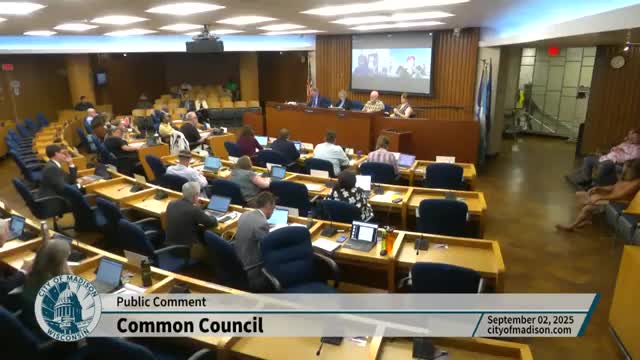Neighborhood Voices Strong Opposition Against Sidewalk Reconstruction Project
September 03, 2025 | Madison, Dane County, Wisconsin
This article was created by AI summarizing key points discussed. AI makes mistakes, so for full details and context, please refer to the video of the full meeting. Please report any errors so we can fix them. Report an error »

The Common Council meeting held on September 2, 2025, in Madison, Wisconsin, highlighted significant community concerns regarding local infrastructure and land use. The discussions primarily revolved around two key issues: the proposed sidewalk reconstruction in certain neighborhoods and an amendment to a view preservation easement for Merrill Springs Park.
Residents from neighborhoods slated for sidewalk reconstruction voiced strong opposition to the project. One local resident expressed frustration over the city's decision to mandate sidewalks in low-traffic areas, arguing that the changes would disrupt the character of their community. Concerns were raised about the loss of on-street parking and the narrowing of roads, which residents believe would negatively impact their neighborhood's aesthetics and functionality. The speaker emphasized that the community had previously expressed a desire against sidewalks, feeling unheard by city officials. This sentiment of being disregarded was echoed by others in attendance, who urged the council to reconsider the project and engage in more open communication with residents.
In a separate discussion, the council addressed an amendment to a view preservation easement for Merrill Springs Park. Faith Fitzpatrick, representing the Friends of Merrill Spring Park, opposed the amendment, arguing that it would extend the viewshed for a landowner beyond the original intent, potentially compromising public access and the park's natural beauty. Fitzpatrick urged the council to reject the amendment, citing concerns about the impact on vegetation and the park's environment.
Conversely, Jessica Harrison, a property owner affected by the easement, clarified that the amendment aimed to reduce confusion surrounding the original easement's terms. She assured the council that the amendment would not encroach on the park and would include specific height limits for vegetation, ensuring the preservation of existing trees.
The meeting underscored the ongoing tension between community desires and city planning initiatives. As residents continue to advocate for their preferences, the council faces the challenge of balancing infrastructure development with the preservation of neighborhood character and public spaces. The outcome of these discussions will likely shape future interactions between city officials and the community, as both sides seek to find common ground on these pressing issues.
Residents from neighborhoods slated for sidewalk reconstruction voiced strong opposition to the project. One local resident expressed frustration over the city's decision to mandate sidewalks in low-traffic areas, arguing that the changes would disrupt the character of their community. Concerns were raised about the loss of on-street parking and the narrowing of roads, which residents believe would negatively impact their neighborhood's aesthetics and functionality. The speaker emphasized that the community had previously expressed a desire against sidewalks, feeling unheard by city officials. This sentiment of being disregarded was echoed by others in attendance, who urged the council to reconsider the project and engage in more open communication with residents.
In a separate discussion, the council addressed an amendment to a view preservation easement for Merrill Springs Park. Faith Fitzpatrick, representing the Friends of Merrill Spring Park, opposed the amendment, arguing that it would extend the viewshed for a landowner beyond the original intent, potentially compromising public access and the park's natural beauty. Fitzpatrick urged the council to reject the amendment, citing concerns about the impact on vegetation and the park's environment.
Conversely, Jessica Harrison, a property owner affected by the easement, clarified that the amendment aimed to reduce confusion surrounding the original easement's terms. She assured the council that the amendment would not encroach on the park and would include specific height limits for vegetation, ensuring the preservation of existing trees.
The meeting underscored the ongoing tension between community desires and city planning initiatives. As residents continue to advocate for their preferences, the council faces the challenge of balancing infrastructure development with the preservation of neighborhood character and public spaces. The outcome of these discussions will likely shape future interactions between city officials and the community, as both sides seek to find common ground on these pressing issues.
View full meeting
This article is based on a recent meeting—watch the full video and explore the complete transcript for deeper insights into the discussion.
View full meeting
